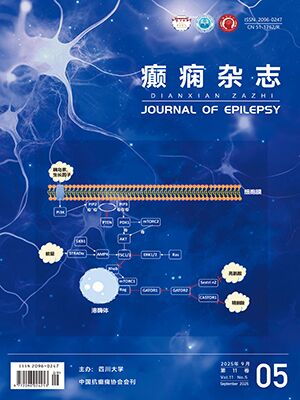| 1. |
Gospe SM Jr. Neonatal vitamin-responsive epileptic encephalopathies. Chang Gung Med J, 2010, 33(1): 1-12.
|
| 2. |
Luo M, Tanner JJ. Structural basis of substrate recognition by aldehyde dehydrogenase 7A1. Biochemistry, 2015, 54(35): 5513-5522.
|
| 3. |
Struys EA, Nota B, Bakkali A, et al. Pyridoxine-dependent epilepsy with elevated urinary α-amino adipicsemialdehyde in molybdenum cofactor deficiency. Pediatrics, 2012, 130(6): e1716-e1719.
|
| 4. |
张晓莉, 王丽君, 贾天明, 等.基因确诊的吡哆醇依赖性癫痫一例.中国优生与遗传杂志, 2015, 23(10): 92-93.
|
| 5. |
杨莉, 李玉芬, 徐丽云, 等.幼儿间断抽搐1年半伴发育落后.中国当代儿科杂志, 2017, 19(1): 73-76.
|
| 6. |
杨莉, 李玉芬, 徐丽云, 等.幼儿间断抽搐1年半伴发育落后.中国当代儿科杂志, 2017, 19(1): 73-76.
|
| 7. |
薛姣, 杨志仙, 李慧, 等.吡哆醇依赖性癫痫的临床和遗传学特点及尿液哌啶酸的检测.中华儿科杂志, 2016, 54(8): 592-596.
|
| 8. |
Plecko B, Paul K, Paschke E, et al. Biochemical and molecular characterization of 18 patients with pyridoxine-dependent epilepsy and mutations of the antiquitin (ALDH7A1) gene. Hum Mutat, 2007, 28(1): 19-26.
|
| 9. |
Mills PB, Footitt EJ, Mills KA, et al. Genotypic and phenotypic spectrum of pyridoxine-dependent epilepsy (ALDH7A1 deficiency). Brain, 2010, 133(Pt 7): 2148-2159.
|
| 10. |
Bok LA, Halbertsma FJ, Houterman S, et al. Long-term outcome in pyridoxine-dependent epilepsy. Dev Med Child Neurol, 2012, 54(9): 849-854.
|
| 11. |
Friedman SD, Ishak GE, Poliachik SL, et al. Callosal alterations in pyridoxine-dependent epilepsy. Dev Med Child Neurol, 2014, 56(11): 1106-1110.
|
| 12. |
Bok LA, Maurits NM, Willemsen MA, et al. The EEG response to pyridoxine-Ⅳ neither identifies nor excludes pyridoxine-dependent epilepsy. Epilepsia, 2010, 51(12): 2406-2411.
|




